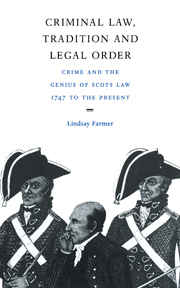Book contents
- Frontmatter
- Contents
- Acknowledgements
- 1 The boundaries of the criminal law: criminal law, legal theory and history
- 2 The genius of our law: legality and the Scottish legal tradition
- 3 The judicial establishment: the transformation of criminal jurisdiction 1747–1908
- 4 The ‘well-governed realm’: crime and legal order 1747–1908
- 5 The perfect crime: homicide and the criminal law
- 6 Conclusion: crime and the genius of Scots law
- Bibliography
- Index
3 - The judicial establishment: the transformation of criminal jurisdiction 1747–1908
Published online by Cambridge University Press: 08 January 2010
- Frontmatter
- Contents
- Acknowledgements
- 1 The boundaries of the criminal law: criminal law, legal theory and history
- 2 The genius of our law: legality and the Scottish legal tradition
- 3 The judicial establishment: the transformation of criminal jurisdiction 1747–1908
- 4 The ‘well-governed realm’: crime and legal order 1747–1908
- 5 The perfect crime: homicide and the criminal law
- 6 Conclusion: crime and the genius of Scots law
- Bibliography
- Index
Summary
Introduction
Beginning his treatise on the trial and punishment of crimes, Hume uses the term ‘the judicial establishment’ to describe the nature and powers of the various criminal courts in Scotland. One of his principal concerns is that of establishing the ancient and independent lineage of the central, royal courts, in order to underline their contemporary status as sovereign and independent courts of law. That this goes so clearly beyond the declared remit of the work, that of the mere practical exposition of the rules governing the jurisdiction of the various courts, should no longer surprise us. By establishing their historical pedigree, and by presenting the account as a series of practical legal questions, the argument seeks to place the courts beyond history – that is to say, beyond political pressures and demands and into the universal and particularistic present of the law. The term is thus particularly apt, conveying the sense not only of the structure but also of the permanence of the courts. In this chapter, we shall also take up the analysis of the ‘judicial establishment’. In particular, we shall examine developments in the area of criminal jurisdiction – understood in the loose sense of the spatial ordering and application of the criminal law – in the century following the publication of Hume's work. But in doing this we shall go beyond the Humean account of jurisdiction in more than the temporal sense, for we shall elaborate an additional sense of the ‘judicial establishment’.
- Type
- Chapter
- Information
- Criminal Law, Tradition and Legal OrderCrime and the Genius of Scots Law, 1747 to the Present, pp. 57 - 99Publisher: Cambridge University PressPrint publication year: 1996



